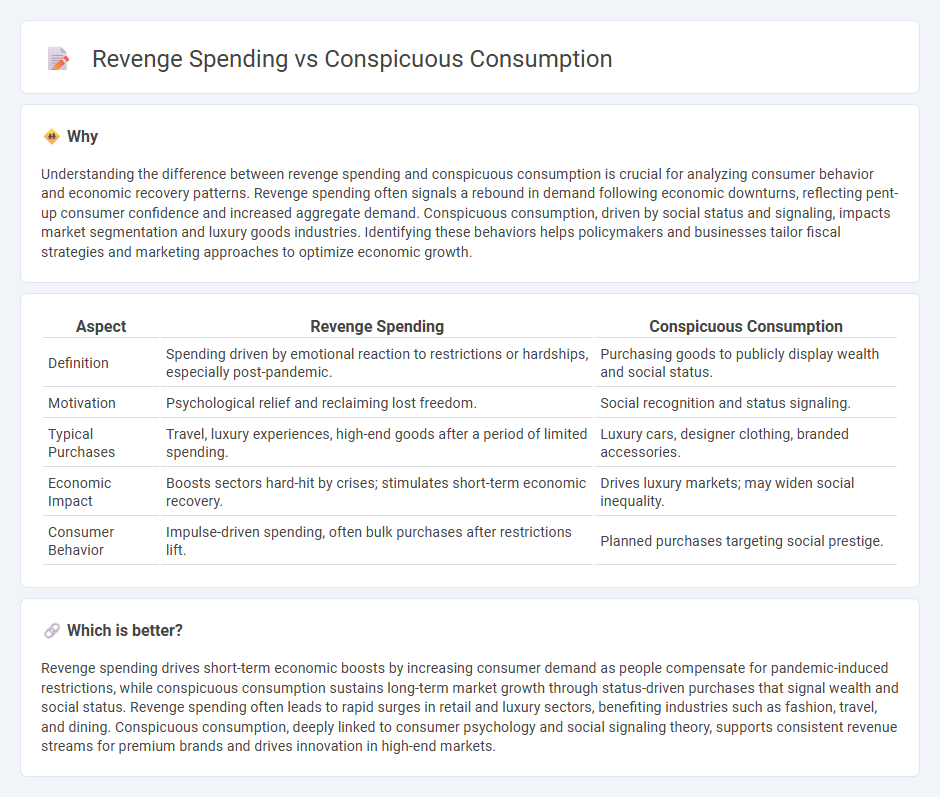
Revenge spending refers to the surge in consumer purchases as people seek to make up for lost time and restricted spending during economic downturns or pandemics, often fueled by pent-up demand and emotional impulses. Conspicuous consumption involves buying luxury goods and services to publicly display wealth and social status, driven by societal pressures and the desire for prestige. Explore the nuances and economic impacts of these distinct spending behaviors for deeper insights.
Why it is important
Understanding the difference between revenge spending and conspicuous consumption is crucial for analyzing consumer behavior and economic recovery patterns. Revenge spending often signals a rebound in demand following economic downturns, reflecting pent-up consumer confidence and increased aggregate demand. Conspicuous consumption, driven by social status and signaling, impacts market segmentation and luxury goods industries. Identifying these behaviors helps policymakers and businesses tailor fiscal strategies and marketing approaches to optimize economic growth.
Comparison Table
| Aspect | Revenge Spending | Conspicuous Consumption |
|---|---|---|
| Definition | Spending driven by emotional reaction to restrictions or hardships, especially post-pandemic. | Purchasing goods to publicly display wealth and social status. |
| Motivation | Psychological relief and reclaiming lost freedom. | Social recognition and status signaling. |
| Typical Purchases | Travel, luxury experiences, high-end goods after a period of limited spending. | Luxury cars, designer clothing, branded accessories. |
| Economic Impact | Boosts sectors hard-hit by crises; stimulates short-term economic recovery. | Drives luxury markets; may widen social inequality. |
| Consumer Behavior | Impulse-driven spending, often bulk purchases after restrictions lift. | Planned purchases targeting social prestige. |
Which is better?
Revenge spending drives short-term economic boosts by increasing consumer demand as people compensate for pandemic-induced restrictions, while conspicuous consumption sustains long-term market growth through status-driven purchases that signal wealth and social status. Revenge spending often leads to rapid surges in retail and luxury sectors, benefiting industries such as fashion, travel, and dining. Conspicuous consumption, deeply linked to consumer psychology and social signaling theory, supports consistent revenue streams for premium brands and drives innovation in high-end markets.
Connection
Revenge spending, characterized by a surge in consumer purchases following periods of restricted access, often drives conspicuous consumption, where individuals buy luxury goods to signal status and wealth. The connection lies in the psychological motivation to reclaim social identity and display financial recovery through visible, high-value acquisitions. This behavior impacts economic indicators by increasing demand in luxury markets and influencing trends in consumer confidence and retail sales.
Key Terms
Status Signaling
Conspicuous consumption involves purchasing luxury goods to publicly display wealth and enhance social status, while revenge spending reflects a compensatory response to lost time or missed opportunities, often triggered by psychological needs rather than purely social signaling. Both behaviors serve as status signals but differ in motivation: conspicuous consumption emphasizes social prestige, whereas revenge spending addresses emotional recovery and self-reward. Explore the distinct psychological and social dynamics behind these spending patterns to understand their impact on consumer behavior.
Emotional Spending
Emotional spending encompasses both conspicuous consumption and revenge spending, where the former involves purchasing luxury goods to display wealth and status, while the latter is driven by a desire to compensate for emotional distress or loss. Conspicuous consumption targets social recognition and self-image, often linked to brands like Gucci and Rolex, whereas revenge spending emerges post-crisis, such as after lockdowns, fueling quick rebounds in retail and entertainment sectors. Explore how emotional motives shape consumer behavior and brand strategies in today's market.
Social Comparison
Conspicuous consumption involves purchasing luxury goods to display social status and gain admiration, often driven by upward social comparison. Revenge spending, triggered by emotional responses to social stress or deprivation, also reflects social comparison but aims to restore self-worth through immediate gratification rather than status signaling. Explore how these spending behaviors intertwine with social comparison processes to better understand consumer psychology.
Source and External Links
24 Conspicuous Consumption Examples (2025) - Conspicuous consumption is the practice of purchasing and displaying luxury goods and services mainly to flaunt wealth and social status, motivated by impressing others rather than the utility of the products.
Veblen's Theory of Conspicuous Consumption - The theory, introduced by Thorstein Veblen, explains conspicuous consumption as acquiring luxury goods to publicly demonstrate wealth and social prestige, a behavior traceable to status signaling in early societies.
Conspicuous consumption - Wikipedia - This term describes buying expensive, non-essential goods conspicuously to display wealth, including behaviours such as costly leisure and luxury fashion, and can extend to conspicuous compassion as a form of social status signaling.
 dowidth.com
dowidth.com